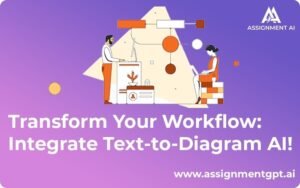In today’s fast-paced digital landscape, the ability to streamline workflows and enhance productivity is paramount. One innovative solution that has gained significant traction in recent years is text-to-diagram AI. This technology revolutionizes the way information is processed, communicated, and understood, offering a host of benefits for individuals and organizations alike.
Understanding Text-to-Diagram AI
Text-to-diagram AI is a sophisticated tool that converts textual information into visual diagrams or charts automatically. This includes processes such as mind mapping, flowchart generation, and concept mapping. By leveraging advanced natural language processing (NLP) and machine learning algorithms, text-to-diagram AI can analyze text input and generate corresponding visual representations swiftly and accurately.
The benefits of Ai diagram generators are manifold. Firstly, it enhances comprehension by presenting complex information in a visually intuitive format. Visual diagrams are easier to digest and interpret than lengthy textual descriptions, making them ideal for conveying intricate concepts or relationships. Additionally, text-to-diagram AI facilitates knowledge retention by appealing to visual learners and providing a structured framework for organizing information.
Integrating Text-to-Diagram AI into Your Workflow
Integrating text-to-diagram AI into your workflow is a straightforward process that can yield significant dividends in terms of efficiency and effectiveness. The first step is to identify the tasks or processes where visual representation can add value. This could include brainstorming sessions, project planning, data analysis, or educational content creation.
Next, select a text-to-diagram AI tool or software platform that aligns with your specific requirements and preferences. There are numerous options available, ranging from standalone applications to integrated suites within productivity software. Look for features such as customizable templates, collaboration capabilities, and seamless integration with existing tools and systems.
Once you have chosen a text-to-diagram AI solution, familiarize yourself with its functionality and features. Most platforms offer intuitive interfaces and user-friendly tools for creating, editing, and sharing visual diagrams. Experiment with different visualization styles, layouts, and formatting options to find the approach that best suits your needs.
Enhanced Communication and Collaboration
One of the primary benefits of integrating text-to-diagram AI into your workflow is enhanced communication and collaboration. Visual diagrams serve as powerful communication tools, enabling you to convey complex ideas or processes in a concise and accessible manner. Whether you’re presenting a project proposal, explaining a concept to colleagues, or illustrating a workflow to stakeholders, visual diagrams can facilitate clearer understanding and alignment.
Moreover, text-to-diagram AI promotes collaboration by enabling real-time sharing and editing of visual diagrams. Team members can collaborate on diagrams simultaneously, regardless of their geographical location, fostering synergy and productivity. This collaborative approach ensures that everyone is on the same page and can contribute to the development and refinement of ideas.
Read more, Streamlining Success: Management Assignment Help Services
Streamlining Processes with Text-to-Diagram AI
Another significant advantage of text-to-diagram AI is its ability to streamline processes and workflows. By automating the creation of visual diagrams, text-to-diagram AI reduces the time and effort required to generate and update documentation. This allows you to focus on higher-value tasks and strategic initiatives, rather than getting bogged down in manual diagramming work.
Furthermore, text-to-diagram AI promotes consistency and accuracy across documentation by eliminating human errors and inconsistencies. Visual diagrams generated by AI are precise and standardized, ensuring clarity and coherence in communication. This consistency enhances the quality of deliverables and reduces the risk of misunderstandings or misinterpretations.
Examples of Text-to-Diagram AI Use Cases
Text-to-diagram AI finds applications across a wide range of industries and domains, revolutionizing how information is communicated and processed. In education, teachers use text-to-diagram AI to create engaging visual aids for lessons and presentations, enhancing student comprehension and retention. In business, professionals leverage text-to-diagram AI for project management, process mapping, and strategic planning, streamlining operations and driving innovation.
Overcoming Challenges
While text-to-diagram AI offers numerous benefits, it is not without its challenges. Common obstacles include compatibility issues with legacy systems, data security concerns, and resistance to change among users. To overcome these challenges, organizations must invest in comprehensive training and support programs, prioritize data privacy and security, and foster a culture of innovation and adaptability.
Future Trends in Text-to-Diagram AI
Looking ahead, the future of Text to diagram ai promises continued innovation and evolution. Advancements in NLP, machine learning, and data visualization technologies will enable even greater levels of automation, personalization, and sophistication. Text-to-diagram AI will become increasingly integrated into everyday workflows, empowering individuals and organizations to communicate, collaborate, and innovate more effectively.
Conclusion
In conclusion, integrating text-to-diagram AI into your workflow can transform the way you work, communicate, and collaborate. By harnessing the power of visual representation, text-to-diagram AI enhances comprehension, streamlines processes, and fosters creativity and innovation. Embrace text-to-diagram AI today and unlock new possibilities for productivity and success.
Faq’s
- How does text-to-diagram AI differ from traditional diagramming tools? Text-to-diagram AI automates the process of creating visual diagrams from text input, whereas traditional diagramming tools require manual creation. This automation saves time and ensures accuracy.
- Can text-to-diagram AI be customized to suit specific industry requirements? Yes, text-to-diagram AI can be customized to accommodate various industries and specific needs. Users can tailor the tool to their industry terminology, workflow processes, and visual style preferences.
- Are there any limitations or drawbacks to using text-to-diagram AI? While text-to-diagram AI offers numerous benefits, potential limitations include the need for high-quality input text for accurate diagram generation and the learning curve associated with mastering the tool. Additionally, some platforms may have limitations in terms of customization options or compatibility with certain systems.
